CLARENCE ROBERTS
Our story begins in the small community of Onaway, Michigan with a consistent population of about one thousand residents. Onaway is located in the northern half of Michigan's Lower Peninsula, in Presque Isle County. The town was founded in the 1880s and was originally incorporated as a village in 1889. Like so many of the early Michigan towns it was supported by the logging industry.
Today, Onaway is sustained by light industry and tourism. It is billed as the 'Sturgeon Capital of Michigan' with the nearby Black Lake housing populations of sturgeon that can reach sizes in excess of 200 pounds. The Ocqueoc River, just a few short miles from town, contains populations of brook, brown and rainbow trout; and supports a spectacular spring and fall salmon run. The nearby Ocqueoc waterfalls are the largest in the Lower Peninsula.
In the very early 1900s Oscar and Mabel Roberts settled in this small community, where Oscar was the foreman at the local grain elevator, Hankey Milling. On January 28, 1916, Clarence Adelbert Roberts was born into a family which eventually totaled seven children.
Family Life
Clarence, along with his siblings attended Onaway High School. It was here that he would meet his one true love and future wife, Lucille Staub. Clarence graduated in 1934. With money he had saved from working at the grain elevator, he attended the Presque Isle County Normal School. After a year of training, Clarence received his teaching certificate.
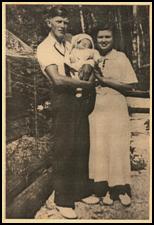 In October of 1936 Clarence and Lucille were married. They moved to Petoskey, Michigan, where he taught school for about three years in a one room school house in the nearby town of Ocqueoc. Many of his students were Polish immigrants who spoke little or no English. His wife Lucille had a teaching certificate as well and taught for a while.
In October of 1936 Clarence and Lucille were married. They moved to Petoskey, Michigan, where he taught school for about three years in a one room school house in the nearby town of Ocqueoc. Many of his students were Polish immigrants who spoke little or no English. His wife Lucille had a teaching certificate as well and taught for a while.
Around 1939, Clarence left teaching and secured employment with the fisheries division of the Michigan Department of Conservation (now the Department of Natural Resources). He was assigned to the Oden State Fish Hatchery in Alanson, Michigan, where he worked as a hatchery assistant and maintenance man. The hatchery was a state of the art rearing facility for brown and rainbow trout until 2002 when it was converted to a Michigan Fisheries Interpretation and Visitor Center.
One day in 1941 he was approached by a supervisor who asked Clarence if he wanted to become a 'game warden'. More prestige and more money; Clarence said yes (the DNR has confirmed that this method of recruitment was consistent with their policies during this time period). The Higgins Lake Training Center (now the Ralph A. MacMullan Conference Center) had just been completed and they were looking forward to holding their first training class for 'game wardens' at the newly constructed facility. Clarence was among the first graduating class, in early 1942. Soon after graduation, Clarence and his family moved to Grayling. He was assigned to Crawford County along with another game warden, named Russell Wright.
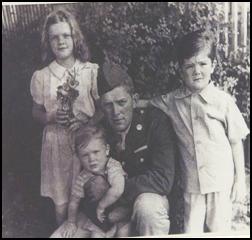 During World War II, the anticipation of the invasion of Japan resulted in Clarence getting drafted into the Army Infantry in April of 1945. He was trained as an MP and assigned to the 28th Infantry Division. His unit was scheduled to ship out for the invasion, however the dropping of the atomic bomb brought the war to a close and Clarence's service was no longer needed. He was honorably discharged in December of 1945, having served only eight months of active duty. With his discharge in hand Clarence returned home to his Grayling job as a game warden, and his family, Lucille, and his three children, Michael, Donald and Jean.
During World War II, the anticipation of the invasion of Japan resulted in Clarence getting drafted into the Army Infantry in April of 1945. He was trained as an MP and assigned to the 28th Infantry Division. His unit was scheduled to ship out for the invasion, however the dropping of the atomic bomb brought the war to a close and Clarence's service was no longer needed. He was honorably discharged in December of 1945, having served only eight months of active duty. With his discharge in hand Clarence returned home to his Grayling job as a game warden, and his family, Lucille, and his three children, Michael, Donald and Jean.
With the low wages of a game warden, raising and supporting a family in Grayling during the 40s and 50s was a challenge. On more than one occasion the family was called together to assist with projects like tying 'ice flies' for large orders and for the annual butchering of roosters --- used for hackle and meat, all of which helped with the family expenses.
Even in tough times, the family scraped together enough money for occasional vacations to places like Yellowstone, Washington D.C. and occasional fishing trips to Canada. Clarence fished as often as possible with his children and as they got older he became active in scouting with them.
In 1947 Clarence, with a good sense of humor, participated in the first Au Sable river race. He was not an official entry however. Clarence and another person dressed up as women and dropped their canoe (full of water) in the river and paddled across the finish line --- they called themselves the "Hoop-T-Do" sisters.
When the Michael & Donald graduated from high school they went on to college. There is a common misconception that Clarence, being a prolific tyer, paid for the boys' education. This simply is not true. The boys saved and paid for their own college education by working as meat cutters, along with other jobs. Clarence did however send them occasional pocket money which helped to pay for their incidentals.
Expert Fisherman
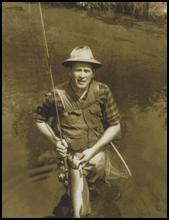 By the age of ten Clarence was already an avid fisherman. His older brother Earl was quite the outdoorsman and involved all his younger brothers in hunting and fishing. By the time Clarence was a young man, he was well versed as a fisherman and, as an adult, he was considered extremely accomplished; so much so that he was a field tester for Shakespeare and other companies.
By the age of ten Clarence was already an avid fisherman. His older brother Earl was quite the outdoorsman and involved all his younger brothers in hunting and fishing. By the time Clarence was a young man, he was well versed as a fisherman and, as an adult, he was considered extremely accomplished; so much so that he was a field tester for Shakespeare and other companies.
Clarence fished with an automatic reel and a $5.00 fiberglass rod. He didn't believe in wasting his time reeling up line and never liked expensive rods for fear that he'd "slam them in the trunk." Although he fished all of the great rivers in and around Grayling, his all time favorite fishing spot was the South Branch of the Au Sable --- "that's where the big fish were!"
Back in the mid 1950s Clarence used to organize fishing trips to northern Saskatchewan, Canada, where the guys would fish for grayling, trout and walleye. He would charter a DC-3, into the Grayling Airport to pick everyone up. Clarence had to round up 25 fishermen willing to pay the price to go --- he never had a problem! In exchange for his efforts he got to go free.
Guiding
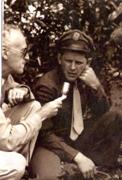
Mort Neff interviewing
Clarence Roberts for 'Michigan
Outdoors' television show. The show ran from 1951 to 1974. Mort was no stranger to the Grayling, Michigan area. He would come up at least twice a year, once for the trout opener and again for the deer firearms season. He was a frequent patron at 'Spikes Keg-O-Nails.'
On one occasion he guided Governor G. Mennen "Soapy" Williams down the Au Sable. By all accounts, Clarence was a very out spoken person and spent much of the day sharing his political opinions with the Governor.
On another occasion, he guided a journalist from National Geographic Magazine down the Au Sable. They were doing a story on the river and Clarence was actually quoted in the article.
There was another time when he guided, Joe Clark. Joe was a famous freelance photographer who did work for Time, Newsweek and National Geographic. On this occasion Joe was doing a photo layout of the Manistee River for an article that he hoped would be picked up by Sports Illustrated.
The renowned Mort Neff of the old Michigan Outdoors television show was also guided down the Au Sable River by Clarence. They were filming a segment for the show so it was necessary to have some real fish action. "Clarence had some of the local fishermen pen up some big browns. When Mort and Clarence came along they simply hooked the fish onto Mort's fly and let the fish perform for the cameras."
Game Warden
As a game warden, they didn't come any better than Clarence. He was ruthless and incorruptible. Back in the 50s game wardens were held in the highest esteem and were always included in the "inner circle" of local hunters and fishermen. Such was the case with Clarence Roberts. If you were involved in hunting, fishing or trapping, he knew who you were. He also had a handle on who the poachers and violators were.
Grayling was a small town. There were two local establishments where most everyone hung out. The first was 'Hanson's Sporting Goods' (Dad Hanson's). The shop was basically a sporting goods store with a few booths where people could sit and have coffee or where the kids could get a soda. The other local hangout was the 'Grayling Restaurant' --- best food in town and a 5¢ cup of coffee. The sportsmen were in and out of these shops all day long, making purchases and swapping lies. Clarence's work and a good cup of coffee often took him to these businesses.
As you can imagine with 29 years as a game warden his anecdotal stories are numerous. Volumes of narrative could never begin to tell the whole story of Clarence's experiences. It is said that he was ruthless. If you were on the side of the law, he was your friend. If you were a violator, you could probably count on seeing the inside of a courtroom or jail.
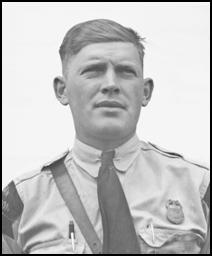 There was one story about his brother-in-law, Henry Schmidt. Henry was an admitted deer poacher. Everyone knew it, including Clarence. Henry had never been caught or arrested. Clarence couldn't very well disassociate himself from the relationship if he ever wanted to visit his sister. According to Henry's son, "when Clarence came to the house to visit, there was a lot of uneasiness."
There was one story about his brother-in-law, Henry Schmidt. Henry was an admitted deer poacher. Everyone knew it, including Clarence. Henry had never been caught or arrested. Clarence couldn't very well disassociate himself from the relationship if he ever wanted to visit his sister. According to Henry's son, "when Clarence came to the house to visit, there was a lot of uneasiness."
In his capacity as a game warden, Clarence helped to organize the first Au Sable River clean up back in 1957. Under Clarence's supervision, the explorer scouts cleaned up about 48 miles of the Au Sable River.
Clarence was cited by his department "as the Game Warden with the largest number of arrest during hunting season for several years in a row." In addition to his regular duties, during the 1960s, he served as an instructor for new recruits at the Higgin's Lake Training School, where he, himself, was trained.
In the words of another journalist, "Roberts was from a rare breed of conservation officers – outspoken, incorruptible, knowledgeable, tough, humorous, hardworking, and dedicated. It was often said of him that he had no friends at all when it came to game laws, and I deeply believe he would have arrested his own mother if she broke the law. He was that kind of officer. A rare breed. ~JP~"
Fly Tyer
The one thing that comes to mind when you think of Michigan and fly fishing is the 'Roberts Yellow Drake' and Clarence Roberts. His fly was and is one of the most popular flies of Michigan lore.
It all started back in the late 1930s, when Clarence's brother Cliff bought "the whole nine yards" of fly tying equipment from a Herters Catalog. When Cliff joined the Army Air Corp in 1942 he passed on all of his tying equipment to Clarence. Fly tying rapidly became not only a hobby but a passion with Clarence. He was good at it, and he loved it.
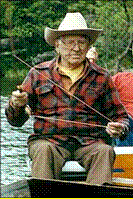
George Griffith (one of the
co-founders of Trout Unlimited) and Clarence were close personal friends and fishing buddies. One day while fishing together on the Au Sable River, George hooked himself in the eye with a fly while retrieving a cast; resulting in the loss of site in one eye. Technology was such that his sight in that eye could not be restored until some 25 years later. Eventually George had the surgery and his sight was recovered.
In 1949 the average family income was around $3,000. Game warden salaries lagged behind the average and Clarence had a growing family to feed and clothe. He decided to start tying commercially to supplement his income. Out of necessity, he became a prolific tyer. He would come home for lunch and tie flies and again, after dinner and any time he had some free time. He sold his flies to 'Dad's', 'Borcher's Canoe Livery,' 'Dave's Sport Shop', the 'Kur-Van Bait Shop' and to dozens of hardware stores and gas stations. In his later years he sold flies out of his house. He raised 200-300 roosters each year for hackle and because of his game warden job, had easy access to road kill deer and other animals for hair and fur.
As a tyer he even found time for students. He taught fly tying to the late Bob Smock (another classic tyer from Grayling) and to his nephew Ray Schmidt along with others. He would often times have tying sessions in the basement of his house, a pot luck dinner kind of affair. The sessions were attended by people such as George Griffith, Ernie Borcher, Jerry McClain, Earl Madsen, Fred Bear and others. After dinner the guys would get together to tie flies and shoot the breeze, play cards and sip a little whiskey.Although Clarence has been attributed with several very famous historic fly patterns designed for Michigan waters, his most famous is the 'Roberts Yellow Drake'. Bob Summers a highly respected tonkin cane rod builder from Traverse City, Michigan, shares with us the story of the fly's creation. In a recent interview, Bob told me that he and George Griffith had been long standing friends and fishing buddies for over twenty-five years. Bob said, "On several occasions George would tell the story how he and Clarence were fishing together. George hooked a log with a big streamer pattern that he was fishing with. When he tugged on it, it popped back and he caught himself in the eye. George couldn't see too well after that so Clarence came up with this fly (Roberts's Yellow Drake) that had white stuff sticking straight up from the hook so George could see it better on the water. George told me this story more then once." I asked Bob if he could date the event and he said, "we're talking late 50s …'57 to'59, somewhere in there."
Roberts' Yellow Drake has multiple uses. It is tied in sizes 2-18 and is used anytime there are yellowish flies on the water. It's also a major player during Michigan's famous 'Hexagenia' hatch. The fly pattern is so famous that it is carried by and used by most every trout fisherman in Michigan. By changing the thread color fishermen have found that it can be used most any time of the year for most any hatch that is going on. The fly is so effective that it is carried by Michigan fishermen to other parts of the country, as their 'go to fly.'
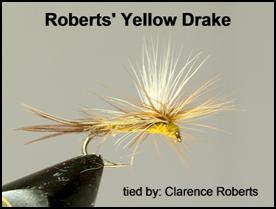 His nephew, Ray Schmidt calls Clarence the "deer-hair master" and rightly so. In Michigan we tie with deer hair; it's abundant, inexpensive and it floats well. Clarence's fly, the Roberts' Yellow Drake, is the epitome of a typical Michigan fly. It is tied parachute, and with deer hair tied parallel to the hook shank. Both of these features were developed in Michigan. Clarence tied more flies with deer hair than any other material.
His nephew, Ray Schmidt calls Clarence the "deer-hair master" and rightly so. In Michigan we tie with deer hair; it's abundant, inexpensive and it floats well. Clarence's fly, the Roberts' Yellow Drake, is the epitome of a typical Michigan fly. It is tied parachute, and with deer hair tied parallel to the hook shank. Both of these features were developed in Michigan. Clarence tied more flies with deer hair than any other material.
Due to a medical condition Clarence took an early retirement from the Department of Natural Resources in 1971, after 29 years of service as a game warden (conservation officer). Shortly after his retirement he and his wife Lucille moved to Stuart, Florida. He liked to fish the surf and still tied flies, but just for his own use. He did some gardening and pursued his new interest as a lapidarian (cutting and polishing gem stones). After more than ten years of retirement Clarence took ill. He and his wife returned to Michigan to be near their families. He passed away on April 8, 1984. Lucille remained in Michigan until her passing on May 25, 2010.
Clarence A. Roberts, family man, expert fisherman, game warden and a prolific iconic Michigan fly tyer, will always be an important part of Michigan history. To Clarence, we say good-by…..
See you on the water…..
 Tom is a retired biology teacher from Michigan. He's been on the water and at the bench for almost 30 years. He's an amateur historian and sports writer, specializing in articles about old Michigan dry flies and old Michigan tyers. He maintains a website, www.michigndryflies.net, where he can be reached.
Tom is a retired biology teacher from Michigan. He's been on the water and at the bench for almost 30 years. He's an amateur historian and sports writer, specializing in articles about old Michigan dry flies and old Michigan tyers. He maintains a website, www.michigndryflies.net, where he can be reached.
This article would not have been possible with out cooperation of friends and family. A special thanks to Clarence's brother Arden Roberts, and to Clarence's sons Mike and Don Roberts and to Ray Schmidt, Clarence's nephew. Also to Bob Summers who helped with the history of Clarence's 'Roberts Yellow Drake.' Additional thanks go to all the other friends and acquaintances of Clarence, whom I interviewed, questioned and badgered. Additional thanks to the Michigan Department of Natural Resources Archives and to the Presque Isle County Clerk's Office.
Copyright 2012©Deschaine
